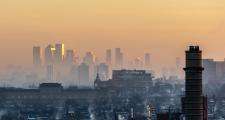Seven ways in which climate change is a child protection issue

Climate change is a child protection concern and is already causing significant physical and emotional harm, campaigners claim.
The warning comes from the Climate Child Protection and Safeguarding Team (CCPST) made up of professionals working in children’s safeguarding.
The group points out that children, particularly those living in deprived areas, are the most vulnerable to the worst impacts of the climate crisis.
The group is seeking to use the law to push for climate-aware policies and action to protect children, highlighting the duty contained within the Children Act (1989) to raise incidents of significant harm or risk of significant harm. The Children Act (2004) reinforces safeguarding as “preventing harm to children’s health or development”.
CCPST is urging social workers and other professionals to include the impact of climate change in safeguarding referrals.
The group highlights seven ways children are being put at harm or risk of harm in the UK:
Air pollution
CCPST says 97 per cent of our air contains pollution above the World Health Organisation’s safe limits. Air pollution increases risk of premature birth, low birthweight, stillbirth and asthma. The group points to the case of nine-year-old London girl Ella Kissi-Debrah who became the first person in the UK to have air pollution listed as a cause of death. The group adds: “Air pollution is also linked to IQ loss and increased risks of autism and attention deficit hyperactivity disorder.”
Chemical pollution
Today’s children are “surrounded by an estimated 350,000 manufactured chemicals, many of which pollute the planet and harm human health” according to CCPST. These can lead to birth defects, neurodevelopmental disorders and cancers later in life. CCPST says: “Children born in industrial areas or areas with high use of agricultural chemicals are at increased risk.”
Flooding
Events such as the floods seen this winter will be an increasing occurrence as weather patterns become more unstable, says the group. More rainfall, also linked to climate change, and flooding combine to increase incidents of harmful black mould, particularly in poorly-heated homes. The group points to the death of two-year-old Awaab Ishak, who died due to extensive mould in the one-bedroom flat where he lived. CCPST says: “The health impacts and dangers of mould for children are significant. Children living in coastal and flood-prone areas and more deprived neighbourhoods are particularly at risk.”
Heatwaves
Severe heatwaves, such as that experienced in the UK in 2022, are expected to become more frequent as climate changes. This poses a greater risk to children who are less able to regulate their body temperature, says the group. Health risks include chronic respiratory conditions, asthma and heat-related mortality.
The group says: “Heatwaves can also affect children’s environments, their safety, nutrition and access to water, and their education and future livelihood.”
Mental health
This is a rapidly growing area of research, says CCPST. The work of Carolyn Hickman shows rising levels of anxiety among children linked to the changing environment. This is compounded by disillusionment that the adults who should be safeguarding their future are not acting, which is causing emotional harm.
The group says: “Children need to see that adults are working to protect them, that we are acting to meet their needs as they are unable to do so themselves.”
Food insecurity
Unstable climate increases the risk of crop failure, which also “doubles” the risk of war and displacement of people. The group highlights the insecurity of ‘just in time’ food import systems being disrupted. This has already been seen at the start of the Ukraine War and, more recently, the attacks by Yemen’s Houthis forcing ships to divert from the Suez Canal. CCPST says: “This makes us especially vulnerable to supply chain issues caused by adverse weather events, war and others. Very little of the food we consume is grown on our shores and we lack a connection to where our food comes from.”
Poverty/health inqualities
CCPST claims evidence shows children are more likely to experience climate harms if they are from a lower socio-economic background, saying: “This will then disproportionately affect children from discriminated or oppressed groups. We do not think it is a coincidence that the two children identified to have died as a result of air pollution and mould in the UK are children of colour.”
